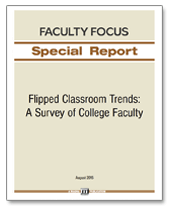
Free Reports
The flipped classroom is a student-centered approach to teaching that involves reversing the design of the learning environment, allowing students to engage in activities, apply concepts, and focus on higher level learning outcomes during class time.
Faculty Focus surveyed its readers to gain a better understanding of their views on flipped learning. The survey also sought to find out who’s flipping, who’s not, and the barriers and benefits to those who flip.
Key findings of the survey
Results from the survey are based on the responses from the 1,089 Faculty Focus readers who completed the survey. Highlights from the 16-page report include:
- More than two-thirds (69.5%) have tried flipping an activity, class, period, or course, and plan to do it again. Another 5.49% have tried flipping, but don’t plan to do it again.
- Roughly one-third (31.8%) of those who have flipped did so within the past year.
- The majority of faculty who have flipped rated the experience as positive for themselves (70.3%) and their students (64.8%).
- The top reasons for flipping include a desire to increase student engagement (79.3%) and improve student learning (75.8%).
- In terms of the actual benefits, nearly three-fourths did see greater student engagement (74.9%), while just over half saw evidence of improved student learning (54.66%).
- More than 80% said students are more collaborative and 76.61% said they ask more questions, while almost half (48.75%) also noted some student resistance.
- The most frequently reported barrier for faculty who want to try flipping is limited time. Nearly 70% said it was a very significant challenge (38.1%) or a significant challenge (31.61%).
- Of those respondents who are not interested in flipped learning, 38.9% said they don’t know enough about it and 27.4% felt it was a fad.
Post Views: 2,726





